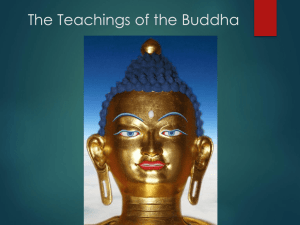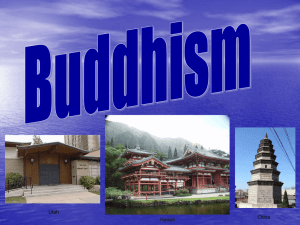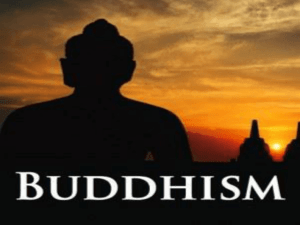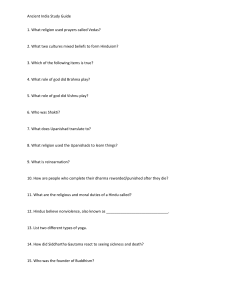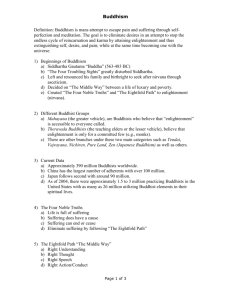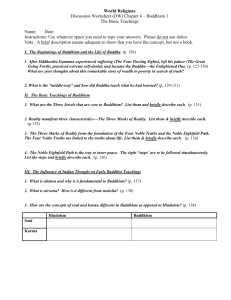Buddhism - ngmsbook
advertisement
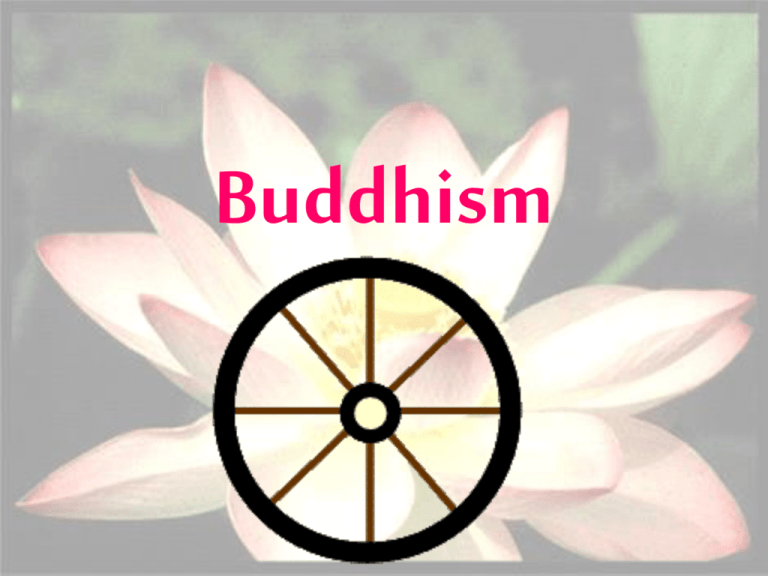
Buddhism World Population appx. 376 m ** 4th largest Country Percent Thailand 95% Cambodia 90 Myanmar 88 Bhutan 75 Sri Lanka 70 Tibet * 65 Laos 60 Vietnam 55 Japan ** 50 Macau 45 Taiwan 43 The Largest Buddhist Communities Top 10 Countries with the Highest Proportion of Buddhists Buddhism: world distribution Origins • developed in India 2500 yrs ago • based on many of the core concepts of Hinduism • essence of Buddhism is the attainment of enlightenment • points to a way of life that avoids selfindulgence and self-denial. • no supreme god or deity in Buddhism Question from your reading: • Who was the founder of Buddhism? Siddhartha Gautama founder • Siddhartha Guatama, or Buddha which means “enlightened one” • lived in the 5th century BC • born into the Kshatriya - caste-led a luxurious lifestyle. • Became troubled by the human misery that he saw around him everyday. • Upon reflection, he deduced that desire was the root caused of all suffering (enlightened under a Bodhi Tree) • not considered a god by his followers Siddhartha Gautama (563-483 BC) Born in NE India (Nepal). Raised in great luxury to be a king. At 29 he rejected his luxurious life to seek enlightenment and the source of suffering. Lived a strict, ascetic life for 6 yrs. Rejecting this extreme, sat in meditation, and found nirvana. Became “The Enlightened One,” at 35. What is the fundamental cause of all suffering? Desire! Therefore, extinguish the self, don’t obsess about oneself. Four Noble Truths 1. There is suffering in the world. To live is to suffer. (Dukkha) The Buddha found this out when he was young and experienced suffering and death in others. Four Noble Truths 2. The cause of suffering is selfcentered desire and attachments. (Tanha) Question from your reading: • What is the term for a state of “Perfect Peace”? Nirvana Four Noble Truths 3. The solution is to eliminate desire and attachments. (Nirvana = “extinction”) Four Noble Truths 4. To reach nirvana, one must follow the Eightfold Path. Major Beliefs 1. The Four Noble Truths Siddhartha's philosophy of the nature of human suffering and its relation to desire is articulated by these four statements: • • • • Life is full of pain and suffering. Human desire causes this suffering. By putting an end to desire, humans can end suffering. Humans can end desire by following the Eightfold Path. Eightfold Path Nirvana The union with the ultimate spiritual reality. Escape from the cycle of rebirth. 2. The Eightfold Path Wisdom 1) Right View – know the truth 2) Right Intention – resist self-centeredness Ethical Conduct 3) Right Speech – refrain from unkind, negative speech 4) Right Action – respect all life 5) Right Livelihood – work for the good of others Mental Discipline 6) Right Effort – exert oneself in freeing the mind of evil (egocentric thought) 7) Right Awareness – elevate one’s thoughts beyond the haze of emotion and mood 8) Right Meditation – practice the discipline of meditation 3. Reincarnation • concept that one must go through many cycles of birth, living, and death • After many such cycles, if a person releases their attachment to desire and the self, they can attain Nirvana - a state of liberation and freedom from suffering • Nirvana can be achieved from meditating and following the guiding principles of Buddhism, such as the Four Noble Truths, 8-fold path 4. Karma - the law that every cause has an effect, i.e., our actions have results. This explains a number of things: inequality in the world, why some are born handicapped and some gifted, why some live only a short life. Buddhists believe that our are past actions have an effect on who or what we are in our next life. 5. Caste System is rejected by Buddhists Symbols of Buddhism • Wheel of Life: represents the endless cycle of life through reincarnation. Each of its eight spokes represents one of the teachings of the Eightfold Path. • Lotus Flower: symbolizes purity and divine birth. The different color lotus flowers have specific meanings: for example, the red lotus signifies the qualities of the heart while the purple lotus is the mystic lotus. An Example of a Wheel of Life An Example of a Wheel of Life An Example of a Wheel of Life Everyday practices 1. Live by this moral code: – Do not take the life of anything living – Do not take anything not freely given – Abstain from sexual misconduct and sensual overindulgence – Refrain from untrue speech – Avoid intoxication – Do not lose mindfulness 2. Meditation: – training the mind to empty it all of thoughts. When this happens what is important comes clear Question from your reading: • What is a person who works to spread their religious beliefs? A missionary Religious Divisions • Theravada Buddhism - found in Burma, Thailand, Sri Lanka, Laos, Cambodia, Myanmar & in part, Indonesia, Vietnam & Malaysia. • Mahayana Buddhism - found in China, Japan, Korea and Vietnam. • Vajrayana Buddhism - found in Tibet, Nepal, Sikkim, Bhutan and Mongolia • Jodo Shin Buddhism or Pure Land Buddhism - mainly from India, Japan • Zen Buddhism - mostly in Japan Spiritual leaders • Monks • Significant leader today: Dalai Lama (Tibetan Buddhism) Question from your reading: • Who is the main god of Buddhism There are no Gods, Not even Buddha himself The Many images of Buddha • Statues of Buddha may include up to 32 symbols. • Any # of these symbols can be used on statues. • (For example, the Buddha is often shown with a bump on on the top of his head. This is a symbol that he had special talents. He is often seen with a round mark on his forehead, which is his third eye. This is a symbol to show that he could see things ordinary people cannot see. He may be shown with curled hair, which is a symbol that he was a very holy man. Sometimes he has long ears, which is a symbol that he came from an important family, and also that he could hear things that other people could not. Buddha – 19c Thailand Buddha ’s head : 2c Pakista n This does not represent Buddha (how do you know?) The legend of the Laughing Buddha


